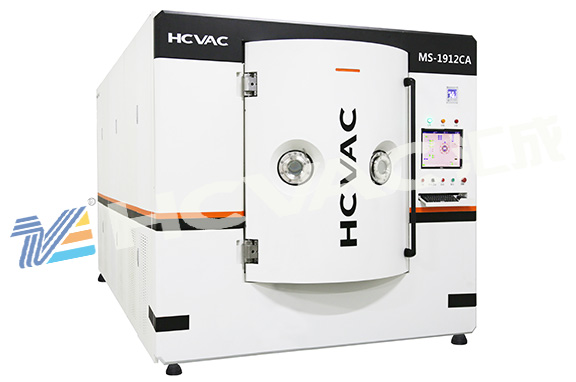pvd coating machine balanced magnetron sputtering, that is, traditional magnetron sputtering, is a permanent magnet or electromagnetic coil with the core and the outer ring magnetic field intensity equal or similar behind the cathode target, and a magnetic field perpendicular to the electric field direction is formed on the surface of the target. The deposition chamber is filled with a certain amount of working gas, usually Ar, which is ionized into Ar+ ions and electrons under high pressure, resulting in glow discharge, Ar+ ions are bombarded by electric field, sputtering target atoms, ions and secondary electrons.

Under the action of perpendicular electromagnetic fields, electrons move in a cycloidal way and are bound to the surface of the target, extending their movement trajectory in the plasma, increasing their participation in the process of gas molecule collision and ionization, ionizing more ions, improving the ionization rate of the gas, and maintaining discharge under low gas pressure. Therefore, magnetron sputtering not only reduces the gas pressure in the sputtering process, but also improves the sputtering efficiency and deposition rate.
However,
pvd coating machine balanced magnetron sputtering also has shortcomings, such as: Due to the magnetic field, the electrons generated by glow discharge and the secondary electrons sputtered are tightly confined near the target surface by the parallel magnetic field, and the plasma region is strongly bound in the area of about 60 mm of the target surface. With the increase of the distance from the target surface, the plasma concentration decreases rapidly. At this time, the workpiece can only be placed within the range of 50 ~ 100 mm on the magnetic control target surface. To enhance the effect of ion bombardment. Such a short effective coating area limits the geometric size of the workpiece to be plated, and is not suitable for large workpieces or furnace loading capacity, restricting the application of magnetron sputtering technology. In equilibrium magnetron sputtering, the energy of the particles flying out of the target is low, the film-base bonding strength is poor, and the mobility of the deposited atoms with low energy on the surface of the matrix is low, and it is easy to form a porous and rough cylindrical structure film. Increasing the temperature of the plated workpiece can improve the structure and performance of the film layer, but in many cases, the workpiece material itself cannot withstand the required high temperature.
The appearance of non-equilibrium magnetron sputtering partially overcomes the above shortcomings, and leads the plasma of the cathode target surface to the range of 200 ~ 300 mm before the sputtering target, so that the substrate is immersed in the plasma, and the sputtered atoms and particles are deposited on the substrate surface to form a film. On the other hand, the plasma bombards the substrate with a certain energy. The non-equilibrium magnetron sputtering system has two structures, one is that the magnetic field strength of the core is higher than that of the outer ring, the magnetic field line is not closed, and it is directed to the wall of the vacuum chamber, and the plasma density on the surface of the substrate is low, so this method is rarely used. The other is that the magnetic field strength of the outer ring is higher than the magnetic field strength of the core, the magnetic field line does not completely form a closed loop, and part of the magnetic field line of the outer ring extends to the surface of the matrix, so that some secondary electrons can escape from the surface area of the target along the magnetic field line, and then collide with neutral particles and ionize. The plasma is no longer completely confined to the surface area of the target, but can reach the surface of the matrix. Further increase the ion concentration in the coating region, so that the substrate ion current density increases, usually up to 5 mA/cm2 or more. In this way, the sputtering source is also an ion source bombarding the surface of the substrate, and the ion beam density of the substrate is proportional to the current density of the target. The increase of the current density of the target will increase the deposition rate, and the increase of the ion beam density of the substrate will play a certain role in bombarding the surface of the deposited film



